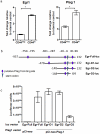Tumor-initiating cells are enriched in CD44(hi) population in murine salivary gland tumor
- PMID: 21858056
- PMCID: PMC3156741
- DOI: 10.1371/journal.pone.0023282
Tumor-initiating cells are enriched in CD44(hi) population in murine salivary gland tumor
Abstract
Tumor-initiating cells (T-ICs) discovered in various tumors have been widely reported. However, T-IC populations in salivary gland tumors have yet to be elucidated. Using the established Pleomorphic Adenoma Gene-1 (Plag1) transgenic mouse model of a salivary gland tumor, we identified CD44(high) (CD44(hi)) tumor cells, characterized by high levels of CD44 cell surface expression, as the T-ICs for pleomorphic adenomas. These CD44(hi) tumor cells incorporated 5-bromo-2-deoxyuridine (BrdU), at a lower rate than their CD44(negative) (CD44(neg)) counterparts, and also retained BrdU for a long period of time. Cell surface maker analysis revealed that 25% of the CD44(hi) tumor cells co-express other cancer stem cell markers such as CD133 and CD117. As few as 500 CD44(hi) tumor cells were sufficient to initiate pleomorphic adenomas in one third of the wildtype mice, whereas more than 1×10(4) CD44(neg) cells were needed for the same purpose. In NIH 3T3 cells, Plag1 was capable of activating the gene transcription of Egr1, a known upregulator for CD44. Furthermore, deletion of sequence 81-96 in the Egr1 promoter region abolished the effect of Plag1 on Egr1 upregulation. Our results establish the existence of T-ICs in murine salivary gland tumors, and suggest a potential molecular mechanism for CD44 upregulation.
Conflict of interest statement
Figures




Similar articles
-
Wnt pathway is involved in pleomorphic adenomas induced by overexpression of PLAG1 in transgenic mice.Int J Cancer. 2006 Feb 1;118(3):643-8. doi: 10.1002/ijc.21400. Int J Cancer. 2006. PMID: 16108035
-
Salivary gland tumors in transgenic mice with targeted PLAG1 proto-oncogene overexpression.Cancer Res. 2005 Jun 1;65(11):4544-53. doi: 10.1158/0008-5472.CAN-04-4041. Cancer Res. 2005. PMID: 15930271
-
Transcription factor early growth response-1 plays an oncogenic role in salivary gland pleomorphic adenoma.Biotechnol Lett. 2020 Feb;42(2):197-207. doi: 10.1007/s10529-019-02776-1. Epub 2019 Nov 30. Biotechnol Lett. 2020. PMID: 31786685
-
Insights into the molecular alterations of PLAG1 and HMGA2 associated with malignant phenotype acquisition in pleomorphic adenoma.Crit Rev Oncol Hematol. 2024 Dec;204:104494. doi: 10.1016/j.critrevonc.2024.104494. Epub 2024 Sep 13. Crit Rev Oncol Hematol. 2024. PMID: 39278426 Review.
-
Molecular Pathology of Salivary Gland Neoplasms: Diagnostic, Prognostic, and Predictive Perspective.Adv Anat Pathol. 2021 Mar 1;28(2):81-93. doi: 10.1097/PAP.0000000000000291. Adv Anat Pathol. 2021. PMID: 33405400 Review.
Cited by
-
Causal relationship between cathepsins and major salivary gland neoplasms: a bidirectional Mendelian randomization study.Gland Surg. 2024 Nov 30;13(11):2148-2162. doi: 10.21037/gs-24-374. Epub 2024 Nov 26. Gland Surg. 2024. PMID: 39678421 Free PMC article.
-
A novel in vivo model for evaluating functional restoration of a tissue-engineered salivary gland.Laryngoscope. 2014 Feb;124(2):456-61. doi: 10.1002/lary.24297. Epub 2013 Aug 6. Laryngoscope. 2014. PMID: 23832678 Free PMC article.
-
Nonadhesive culture system as a model of rapid sphere formation with cancer stem cell properties.PLoS One. 2012;7(2):e31864. doi: 10.1371/journal.pone.0031864. Epub 2012 Feb 16. PLoS One. 2012. PMID: 22359637 Free PMC article.
-
Dysregulated long non‑coding RNAs in pleomorphic adenoma tissues of pleomorphic adenoma gene 1 transgenic mice.Mol Med Rep. 2019 Jun;19(6):4735-4742. doi: 10.3892/mmr.2019.10149. Epub 2019 Apr 11. Mol Med Rep. 2019. PMID: 31059011 Free PMC article.
-
Poorly differentiated salivary gland carcinoma with prominent squamous metaplasia in a pregnant Wistar Hannover rat.J Vet Med Sci. 2016 Jun 1;78(5):859-62. doi: 10.1292/jvms.15-0539. Epub 2016 Jan 18. J Vet Med Sci. 2016. PMID: 26782134 Free PMC article.
References
-
- Reya T, Morrison SJ, Clarke MF, Weissman IL. Stem cells, cancer, and cancer stem cells. Nature. 2001;414:105–111. - PubMed
-
- Hong SP, Wen J, Bang S, Park S, Song SY. CD44-positive cells are responsible for gemcitabine resistance in pancreatic cancer cells. Int J Cancer. 2009;125:2323–2331. - PubMed
-
- Bonnet D, Dick JE. Human acute myeloid leukemia is organized as a hierarchy that originates from a primitive hematopoietic cell. Nat Med. 1997;3:730–737. - PubMed
Publication types
MeSH terms
Substances
LinkOut - more resources
Full Text Sources
Medical
Molecular Biology Databases
Research Materials
Miscellaneous

